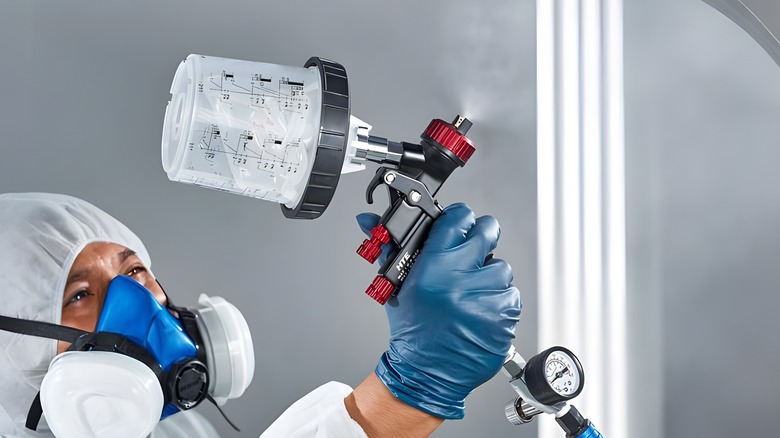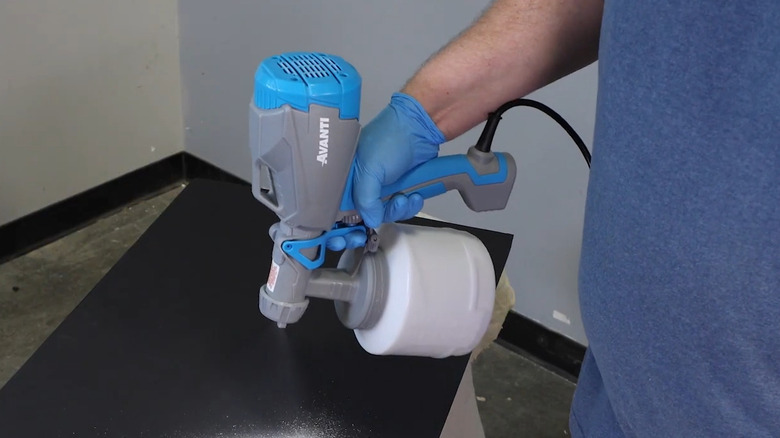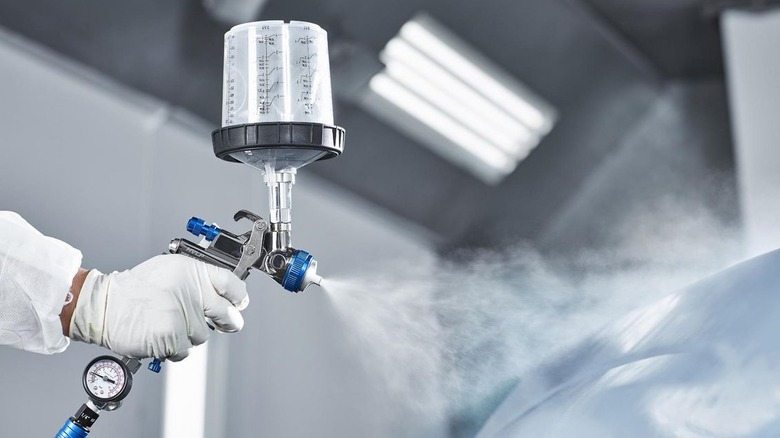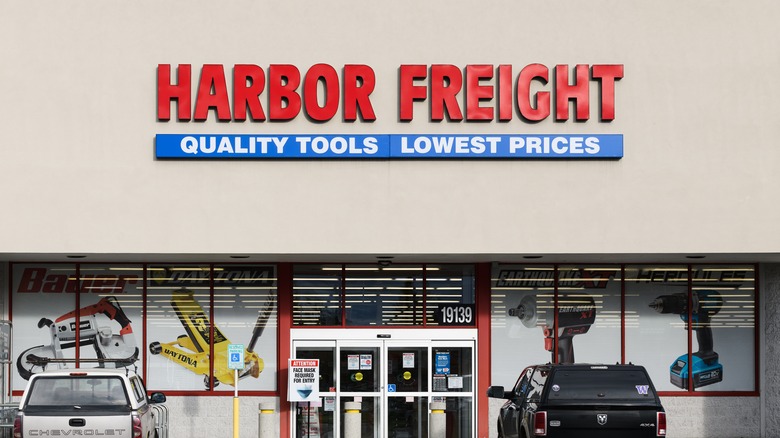HTE Vs. HVLP: Which Harbor Freight Spray Gun Is Right For You?
Perhaps the most important factor to consider when getting ready to update your car or living area with a fresh coat of paint is what you're going to use to paint it. One option you may not have considered is using a spray gun. These handy tools can produce paint easily and efficiently, covering a wide area more quickly than paint brushes or similar methods. But just like paintbrushes, not all spray guns are made equal. Along with conventional paint guns, there are HVLP and HTE options, which have gained popularity in more recent years for a variety of reasons.
Whereas conventional spray guns use lots of air pressure and waste excessive amounts of material, HVLP and HTE guns are designed to provide a more efficient and safe manner of working. There's no shortage of retailers that carry these tools, but for those seeking an economical and varied selection to choose from, it's hard to beat what Harbor Freight has to offer. Even though there are some items from the equipment supplier that you should be wary of, as a whole, Harbor Freight's paint sprayers are considered effective by customers.
Nevertheless, knowing what each spray gun variety brings to the table and the nuances of Harbor Freight's products are key to ensuring you make the right decision for your project. With that out of the way, here's what to know about both HVLP and HTE spray guns.
What to know about HVLP paint spray guns
HVLP is short for High Volume Low Pressure, which tells you what you need to know about this sprayer. While they require lots of air volume to get going, it releases paint at a lower pressure, usually less than 10 PSI compared to a conventional sprayer that can reach 30 PSI.
With a transfer efficiency of between 65% to 90%, HVLP guns greatly cut down on overspray, which is when wasted paint particles go airborne. This is not only more beneficial for the environment and your health but also acts as a more cost-effective method of conserving material, making it especially useful if you're using expensive paint that you don't want to go through all at once. Due to their efficiency, some localities and states recognize HVLP sprayers as the only legal air spray form for professional purposes, so be sure to check your local regulations. HVLP sprayers are generally best suited for paints with low viscosity, such as oil paints, interior wall paints, varnishes, primers, and wood preservatives. Avoid thicker materials that can clog up your spray gun, like water-based latex.
HVLP sprayers still come with some drawbacks. The big downside to a tool that produces such low pressure is that it takes more time to cover a surface. While HVLP spray guns can be used to paint cars when applied correctly, improper use can create an inconsistent bumpy appearance on these surfaces, known as orange peel. They are most effective on more detailed applications such as doors, windows, fences, furniture, and decorative items.
What to know about HTE paint spray guns
As good as HVLP sprayers can be in the right circumstances, they'll never produce quite the same effect as conventional spray guns. For those seeking out a conventional sprayer alternative that performs in a similar manner, an HTE spray gun may be what you're looking for, as they come with a higher PSI than HVLP sprayers.
The HTE acronym stands for High Transfer Efficiency. These sprayers came about as a way of appeasing users who were tired of the limitations that came with HVLP sprayer guns while still staying in line with more recent commercial regulations set by organizations such as the Environmental Protection Agency. While not quite as transfer efficient as an HVLP, HTEs make up for it by producing a finer coat that won't waste as much material as a conventional spray gun. You'll generally find that HTE spray guns can save much more time than HVLP spray guns, making them a better pick for jobs where time is of the essence.
While HTE spray guns typically cost less than HVLP varieties, the opposite seems to be true for those sold at Harbor Freight, where the lowest-costing HTE sprayers go for close to $100. HTE spray guns are good for items like furniture and cars, with the latter seeming to be what Harbor Freight's selection is especially suited for. Some users have also reported inconsistencies with the kinds of materials that HTE guns interact with, such as metallic base coats.
What HTE and HVLP spray guns does Harbor Freight carry?
Ultimately, the kind of spray gun you go for depends on a number of factors. While the use of one or the other may be something strictly determined by the regulations in your area, you should also carefully consider the kind of material you intend to use, its application, and your intent for the final result of the paint job in any and all circumstances before making a decision.
Whichever route you choose, Harbor Freight has no shortage of options that will come in handy for any DIY job. There are five different HVLP spray guns to choose from. Two are from Avanti, with a regular Handheld HVLP Sprayer and a 2 Stage HVLP Sprayer, which cost $69.99 and $139.99 respectively. The lowest cost options are the Central Pneumatic Gravity Feed Air Spray Gun for $16.99 and a version of this with a regulator for $29.99. On the other end of the price spectrum is the $179.99 HVLP Gravity-Feed Air Spray Gun with Rear Fan Control from Black Widow. All of these have been well-received by buyers, with the lowest rated possessing a 4.2 out of 5-star rating average.
Harbor Freight currently carries four HTE spray guns. Two of these are from Spectrum, including the 32 oz. Professional Siphon Air Spray Gun costs $99.99 and the Premium HTE Gravity-Feed Air Spray Gun that comes equipped with a side fan control for $129.99. The other two are a pair of Gravity Feed Spray Guns from Black Widow, one of which contains a rear fan control and the other that uses side fan control. Both cost $179.99. Each of Harbor Freight's HTE spray guns currently holds at least a 4.8 out of 5-star rating, suggesting customers hold these in especially high regard.



